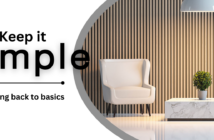by TONYA DYBDAHL
As we make our way through 2021, the guest experience doesn’t look anything like it did just one year ago. As vaccines continue to roll out, states relax their regulations, and hotels begin to increase capacity, there’s a new set of rules and best practices that dictate shared spaces in every hotel.
And for the same reasons, margins are narrow and a full-scale redesign might not be possible. By working with your existing floorplan and adding a few essentials for the “new normal,” you can ensure that your guests stay safe throughout their stay.
DIRECT TRAFFIC FLOW
Managing the flow of traffic throughout your space is difficult in the best of times. Now? This has become a paramount challenge. While there’s no shortage of floor-mounted, wall, or standing signage solutions, there’s a direct benefit in physical, tangible barriers. Look for ways to keep guests moving in one direction, employing crowd control bands that can be repositioned and reused as needed, or find ways to rearrange furniture so that pathways are easier to follow, particularly in large spaces.
This also applies to spacing in stagnant areas. Ensure guests remain 6 feet apart while waiting to check in and impose limits on elevators, restricting the number of unfamiliar parties who are riding at the same time. While these guidelines should be clearly posted, ensure they’re easily communicated during check-in and other interactions with guests.
WHAT CAN STAY
Take a good, hard look at your furniture. From the entryway to the lobby, through dining areas and halls, there’s no shortage of short-use seating. Now, think about your storage space and where you can put excess furniture for the time being. By reducing the quantity of seating, you quickly restrict guests’ behaviors.
Start by arranging your space with the recommended 6-foot distance between sets of seating. For those who travel in groups, you’ll still have clusters of seats, however, it’s best to keep clusters restricted to just four seats each. Using end tables and coffeetables helps keep seats physically well spaced also.
NEW ADDITIONS
After seeing what can stay and what can be stored, there still will be a few new necessities to keep guests and employees safe, such as sneeze guards, wayfinding tools, and sanitizer stations. These movable tools are easy to install in accessible spaces near entrances and high-traffic areas within the lobby and beyond. Many of these are contingent on your existing layout, while others are available as universal solutions that can be ordered or tailored to fit your exact needs.
As you select furniture, make sure your upholstery and finish choices are designed to stand up to the harsh solvents needed to sanitize every surface. Choose durable vinyl over porous fabric and scratch- and stain-resistant laminate over wood or veneer. This further ensures that your pieces will last well beyond the pandemic.
USE PLEXIGLAS
Whether called Plexiglas or acrylic, this product has one purpose: to provide total transparency while maintaining a physical barrier. These see-through panels have always been a staple of the food industry, resulting in the name “sneeze guards,” but their popularity has skyrocketed during COVID-19.
There’s a guard for every need. As the pandemic has progressed, manufacturers have created a wealth of solutions in a variety of sizes, some of which have cutouts for transactions, some wrap around for 3/4 personal coverage, and others may be connected together to form much larger (yet still-sturdy) partitions. Front desks, valet stands, security stations, and any point of interaction between employees and customers should employ these helpful solutions.
FOOD AND BEVERAGE CONSIDERATIONS
Bars and restaurants have been subjected to some of the tightest COVID-19 restrictions, and no matter what, it’s imperative you follow all local, state, and national regulations, as well as best practices that are released by authorities such as the CDC. In accordance with these rules, in-house bars and restaurants found creative ways to make their service safe for everybody.
- All-Weather Outdoor Areas: If you have an outdoor patio, consider exploring one of many ways to make this work during inclement weather, such as small yurts or huts that can be heated through the coldest of days or covered during intense sun.
- Leverage Unused Spaces: Because of COVID regulations, halls or banquet spaces have gone unoccupied. These expansive spaces can easily be transformed into significantly distanced dining areas with ample airflow throughout.
- Keep Patrons Separated: Particularly at bars, ensure that there’s limited seating at the bar itself. To go the extra mile, seek out movable dividers that can be positioned between groups of patrons and quickly cleaned between service.
- Enhance Room Service: You may already have a program in place that provides room service from your kitchen, but in this climate, it’s worth enhancing this benefit. Highlight this service in printed material, online, and at check-in to increase awareness and promotion.
As we continue to navigate this wild, new frontier, we can only manage what’s right in front of us. Keeping on top of changing regulations, ensuring that employees are taking personal precautions, and maintaining a professional and sanitary environment is what we can do for now. Doing our best now will ensure that tomorrow is an even brighter, stronger future.
Tonya Dybdahl is a Space Planning and Design Assistant Manager for National Business Furniture (www.nationalbusinessfurniture.com) and she can be reached at [email protected].




